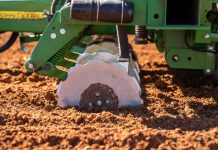
 Prof Sandra Lamprecht, ARC-Plant Health and Protection
Prof Sandra Lamprecht, ARC-Plant Health and Protection
Thabo Phasoana,
ARC-Plant Health and Protection
Crop diseases can spread through various means: for instance, as soilborne, seedborne or waterborne pathogens. However, the development of diseases is primarily influenced by the simultaneous occurrence of three factors: a favourable environment, susceptible hosts, and an adequate presence of disease-causing micro-organisms (pathogen inoculum).
In some cases, seeds are planted in unfavourable soil conditions, such as cold, or excessively dry or wet soils. These adverse soil conditions can create an ideal environment for certain fungal pathogens to thrive and invade the seeds and seedlings, causing damage. Seed treatments, therefore, play a crucial role in safeguarding seeds and seedlings against diseases transmitted through seeds and soil, as well as protecting them from insect pests that can hinder crop emergence and growth. This article aims to highlight the significance of seed treatment as a means of managing plant diseases.
Seed treatment involves the application of biological agents and/or chemicals, such as fungicides, insecticides, and nematicides, either individually or in combination, to protect seeds from harmful organisms and storage insects that can be transmitted through seeds or soil. The application of seed treatments is essential for maintaining seed health by suppressing, controlling, or repelling pathogens, insects, and other pests that can attack seeds, seedlings, or plants.
The advantage of using seed treatments to manage plant pests and diseases is their precise and targeted application, utilising minimal chemicals that specifically target the seeds while minimising harm to the environment. As a result, seed treatment is a cost-effective and environmentally friendly approach. Typically, the chemicals applied to seeds provide protection primarily during the processes of germination, emergence, and early establishment. Therefore, having knowledge about the prevalent diseases on a farm or in a region allows the producer to choose the appropriate active ingredient for seed treatment that specifically targets the particular disease, ensuring effective protection.


A glasshouse trial was conducted by Prof Sandra Lamprecht and Thabo Phasoana from the ARC-Plant Health and Protection. The objective of the trial was to assess the effectiveness of different seed treatment chemicals and biological control agents in combating Sclerotinia on soybean and sunflower. The trial consisted of three treatment groups: individual application of chemicals, individual application of biological agents, and a combination of both chemicals and biocontrol agents. The treated seeds were then planted in soils inoculated with Sclerotinia sclerotiorum.
Results from the study are as follows:
- Seed treatments can protect seedlings against infection by S. sclerotiorum and can significantly improve the survival of soybean and sunflower.
- The chemical products had a higher disease control efficacy than the biological products.
- An interesting result was that certain chemical products and biologicals, when applied alone, were not able to significantly reduce the viability of sclerotia. However, no sclerotia were viable after treatment with a combination of the two products.
- Benomyl, the only seed treatment registered for control of S. sclerotiorum on sunflower, reduced the viability of sclerotia and improved survival in soil inoculated with S. sclerotiorum. It is, however, also important to note that this product will not control some of the other pathogens in the complex that cause damping-off of sunflower and soybean.
- Combining the chemical products with biological products in certain instances resulted in significant improvement in survival and plant height in soil inoculated with S. sclerotiorum.
The results of this study showed that seed treatment can significantly reduce the viability of sclerotia and protect seedlings against S. sclerotiorum inoculum in soil. Seed treatment should, therefore, be an important part of an integrated management strategy against S. sclerotiorum on soybean and sunflower.
Apart from seed health, which includes pests and diseases, seed quality, which encompasses vigour, germination, and emergence, is another crucial factor that can impact a producer’s yields. Utilising certified seed serves as the initial line of defence against different diseases. One advantage of using certified seed is that it undergoes rigorous testing for germination and vigour according to standardised protocols to meet the minimum production standards. Certified seeds are specifically produced by seed companies and are subjected to regular inspections at various stages, including planting, production, harvesting, cleaning, and packaging. It is also important to note that seed quality is of utmost importance regarding chemical seed treatment since chemical seed treatment can have a negative effect on poor-quality seed.
The viability and quality of stored seeds depend on both the initial seed quality and the storage conditions employed. The storage of soybean and sunflower seeds can significantly influence their quality. Inadequate storage conditions can result in reduced seed viability due to heightened metabolic activity, leading to a decline in physiological quality. To ensure optimal storage, it is recommended to maintain a temperature range of 2 °C to 21 °C and a relative humidity below 40% for the seeds. Therefore, it is vital to confirm that the seeds meet the required health and quality standards before planting your crop. Attaining a high-quality seed with an adequate plant stand forms the foundation for profitable soybean and sunflower production and expansion. To enhance production, it is necessary to establish and maintain a source of disease-free, high-quality seeds.




























